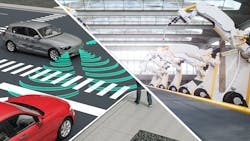Functional Safety Confers Competitive Advantage in Automotive, Industrial Apps (.PDF Download)
From the highway to the factory floor, automation is driving the need for functional safety. Automotive airbag and braking systems have long incorporated functional safety. However, now the trend toward increasing vehicle electrification is extending the need for functional safety to autonomous driving and advanced driver-assistance system (ADAS) functions, battery-management systems, and systems employing sensor fusion. In addition, everything from industrial robotic systems to home appliances can benefit from functional-safety features.
Frequently, automotive and industrial products require certification in accordance with the IEC 61508 industrial and ISO 26262 automotive standards and their respective safety integrity level (SIL) and automotive SIL (ASIL) values. But even if your product doesn’t require certification, building in functional safety can give you a competitive advantage.
